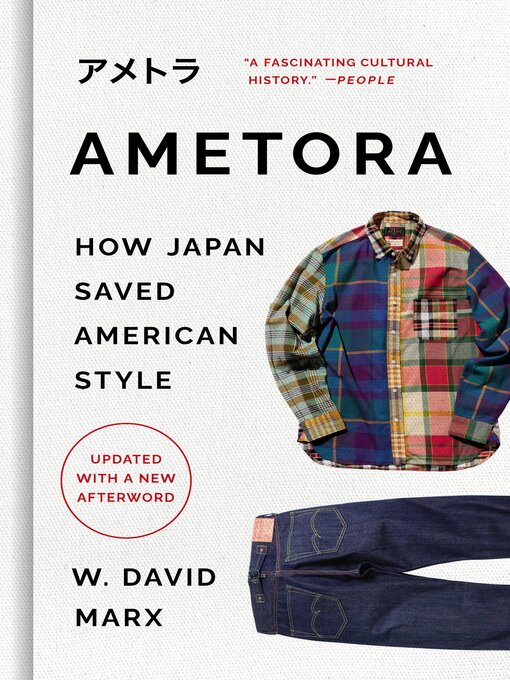Look closely at any typically "American" article of clothing these days, and you may be surprised to see a Japanese label inside. From high-end denim to oxford button-downs, Japanese designers have taken the classic American look—known as ametora, or "American traditional"—and turned it into a huge business for companies like Uniqlo, Kamakura Shirts, Evisu, and Kapital. This phenomenon is part of a long dialogue between Japanese and American fashion; in fact, many of the basic items and traditions of the modern American wardrobe are alive and well today thanks to the stewardship of Japanese consumers and fashion cognoscenti, who ritualized and preserved these American styles during periods when they were out of vogue in their native land.
In Ametora, cultural historian W. David Marx traces the Japanese assimilation of American fashion over the past hundred and fifty years, showing how Japanese trendsetters and entrepreneurs mimicked, adapted, imported, and ultimately perfected American style, dramatically reshaping not only Japan's culture but also our own in the process.
-
Creators
-
Publisher
-
Release date
December 1, 2015 -
Formats
-
Kindle Book
-
OverDrive Read
- ISBN: 9780465073870
- File size: 23243 KB
-
EPUB ebook
- ISBN: 9780465073870
- File size: 80083 KB
-
-
Accessibility
Publisher statement (EPUB)
The publisher provides the following statement about the accessibility of the EPUB file supplied to OverDrive. Experiences may vary across reading systems. After borrowing the book, you may download the EPUB files to read in another reading system.
Ways Of Reading
No information about appearance modifiability is available.
Not all of the content will be readable as read aloud speech or dynamic braille.
Conformance
No information is available.
-
Languages
- English
-
Reviews
-
Publisher's Weekly
Starred review from September 28, 2015
In this wholly intriguing study of the American influence on menswear in Japan, cultural critic Marx carves out a lucid example of the cyclical interplay between cultural identity and globalization by mapping Japan’s rise to prominence in the fashion the world, beginning with the appropriation of American trends after WWII. Japan’s first obsession with American style was called, simply, Ivy (aibii). The term referred to the Ivy League, specifically the style of students walking across the Princeton University campus in 1959, when intrepid Japanese fashion entrepreneur Kensuke Ishizu decided to visit the campus for inspiration. Ishizu was the first of many magazine editors, designers, store owners, and trend setters who would define Japanese style over the next few decades by appropriating—and redefining—iconic American style (as well as archiving it). “The story of Japan’s embrace, reappropriation, and exploration of American style thus stands as a highly illustrative episode of how culture globalizes,” the author writes, nearly understating the significance of his project. The book’s tales of scrappy entrepreneurs combine to make an important contribution to readers’ understanding of cultural authenticity, the use of branding in media to sell consumer goods, and how representations of masculinity and rebellion evolve in the consumer marketplace. B&w photos. -
Library Journal
December 1, 2015
Ametora is local Japanese slang for "American traditional"--the casual look adopted by Ivy League college men and embraced by Japanese youth after World War II. Ironically, the look, as taken up in the East, was associated with delinquency and rebellion. A detailed story of how style-obsessed businessman Kensuke Ishizu and others, including Masayuki Yamazaki, Osamu Shigematsu, and Toshikiyo Hirata, popularized the "Ivy-style" via Ishizu's VAN Jacket Company is told by Marx, a cultural and fashion writer, Harvard graduate, and Tokyo resident. The menswear company was founded in 1959 to sell carefully manufactured copies of the look: blazers, Oxford-cloth button-down shirts, jeans, and cordovan shoes. While the company's fortunes rose and fell (including a bankruptcy in 1978), Ishizu and others ultimately preserved Ametora for export to a global market. Marx's meticulous research draws upon interviews with designers, archival images, and previously untranslated Japanese news. He concludes that the Japanese codified a look that needed no rule book in America, as it was passed down through generations of privileged men. VERDICT Overall, Marx offers a thorough study; however, a deeper analysis into the reasons behind this story of appropriation and cultural exchange would have made for a more satisfying narrative.--Nancy B. Turner, Temple Univ. Lib., Philadelphia
Copyright 2015 Library Journal, LLC Used with permission.
-
Loading
Why is availability limited?
×Availability can change throughout the month based on the library's budget. You can still place a hold on the title, and your hold will be automatically filled as soon as the title is available again.
The Kindle Book format for this title is not supported on:
×Read-along ebook
×The OverDrive Read format of this ebook has professional narration that plays while you read in your browser. Learn more here.


